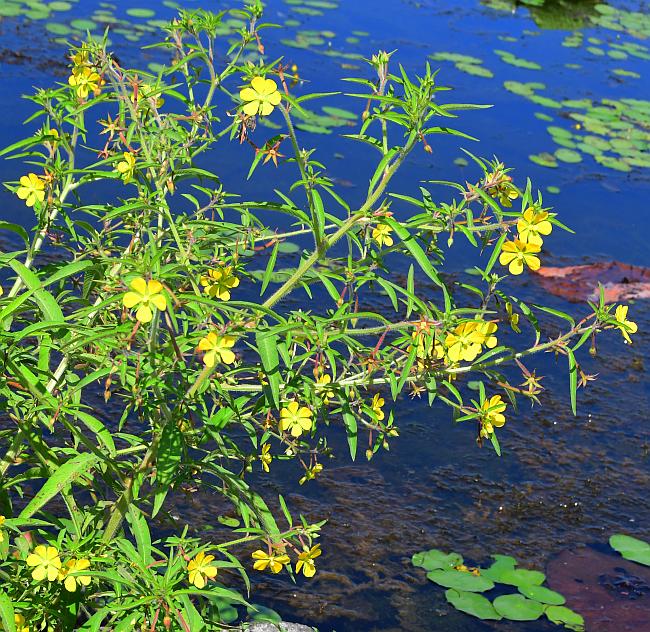Ludwigia leptocarpa (Nutt.) H. Hara
Hairy Primrose Willow

Native
CC = 10
CW = -5
MOC = 11
SRank = S2
© SRTurner
Ludwigia leptocarpa (Nutt.) H. HaraHairy Primrose Willow | |
 |
Native CC = 10 CW = -5 MOC = 11 SRank = S2 |
© SRTurner |
|
Family - Onagraceae Habit - Annual or perennial forb, sometimes woody toward the base, not producing rhizomes, when aquatic usually forming pneumatophores from the roots. Stem - Stems erect or ascending, to 2.5 m, terete, longitudinally lined, densely pubescent with spreading hairs.
Leaves - Leaves alternate, petiolate. Leaf blades to 18 cm, lanceolate to oblanceolate, the margins entire, the surfaces moderately to densely hairy when young, at maturity the pubescence mostly restricted to the main veins, the relatively inconspicuous venation pinnate, but with the secondary veins fused to form a series of submarginal loops. Stipules present, to 0.5 mm.
Inflorescences
Flowers - Axillary, on short stalks, bractlets usually absent. Sepals 5, to 11.0 mm long, lanceolate, tapered to a sharply pointed tip. Petals usually 5, 5-11 mm long, 4-8 mm wide, broadly obovate, broadly rounded or with a shallow notch at the tip, yellow to orangish yellow. Stamens usually 10, the filaments yellow. Pistil 1, with 5-locular inferior ovary.
Fruits - Capsules to 4.5 cm, more or less cylindric, rounded or slightly several-angled, straight or slightly curved, thin-walled, hairy, dehiscing tardily and irregularly. Seeds 1.0-1.2 mm long, loosely embedded in horseshoe-shaped pieces of inner fruit tissue, the surface pale brown, finely pitted, shiny.
Flowering - August - October. Habitat - Riverbanks, margins of ponds and sloughs. Origin - Native to the U.S. Lookalikes - L. peploides, L. grandiflora. Other info. - This species is uncommon in Missouri, with a range mostly restricted to the Mississippi Lowlands Division. More recently, the plant has also been found in a few locations within St. Louis County. Its main range is within the southeastern U.S. The long flowers with showy yellow petals make it a species hard to miss. It can be distinguished from lookalikes by its erect habit and very long fruits on relatively short stalks. The seeds inside the fruits are arranged in five long columns, with each seed embedded in a U-shaped block of tissue. The number of sepals and flower petals is usually 5, with twice that many stamens; however, 6-petaled flowers are not uncommon. The species epithet 'leptocarpa' means 'slender fruits.' Photographs taken at Creve Coeur Lake Memorial Park, St. Louis County, MO 9-30-2015 and 9-26-2019, and at Duck Creek Conservation Area, Stoddard County, MO, 10-18-2017 and 8-17-2021 (SRTurner). |